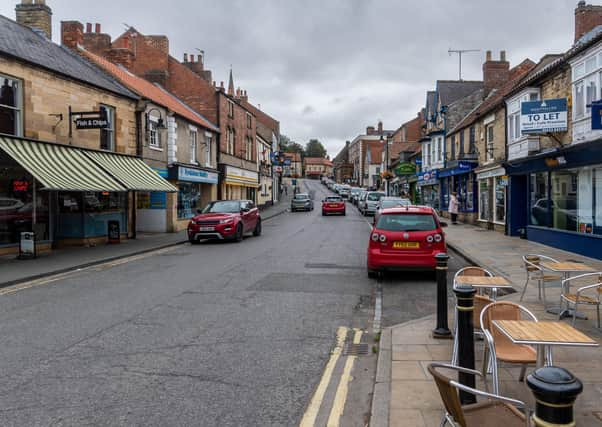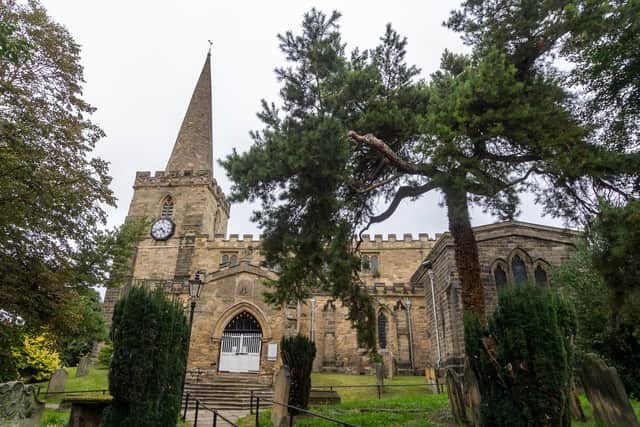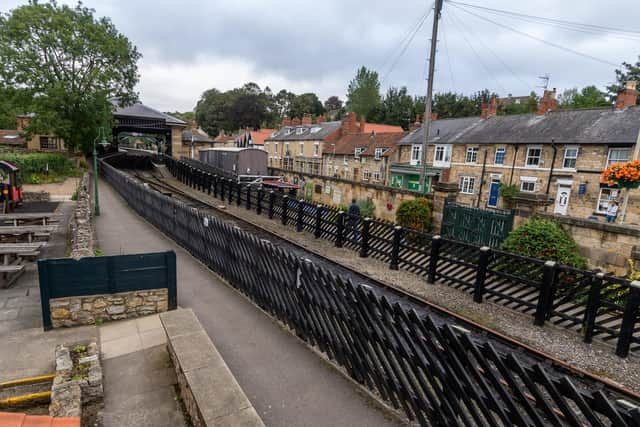Pickering, home to the start of the North Yorkshire Moors Railway and gateway to the past


If you’ve passed through Pickering on your way to visit the North York Moors or the coastal towns and villages beyond without stopping to explore, you’re missing a trick. Of course, this historic market town is very much the gateway to the North York Moors National Park and even markets itself as such, but it’s also well worth a trip in its own right. In fact, you might be surprised by some of the fascinating but, perhaps, lesser-known attractions to be found there.
One of the finest is tucked away to the rear of Market Place, which is lined with an impressive choice of independent shops and eateries, and hosts a popular market every Monday. To find this gem, head for the clearly visible spire of St Peter and St Paul’s, the town’s 12th century, Grade II-listed parish church, and climb one of the sets of stone steps that lead up from the bustling street into the tranquil, shady churchyard beyond.
Advertisement
Hide AdAdvertisement
Hide AdFrom the outside the little church may look typical of the era in which it was built, but inside it are some of the most intact medieval wall paintings in Britain. When I first heard about them and went to investigate, I completely underestimated the scale of the murals and how vivid the colours would be. Not only are they several feet tall, but they line the walls of the nave and are painted in rich, bold tones, grabbing your attention immediately. As you enter the door, you’re greeted by a bloody image of St George slaying a dragon on the opposite wall. The paintings were commissioned in 1450 and painted over the course of the following decade. They depict scenes from the lives of saints, as well as the seven Corporal Acts of Mercy, the Passion and Crucifixion of Christ, the Descent into Hell and Christ’s Resurrection and Ascension. Astonishingly, they were only rediscovered – accidentally – in 1852 when a section of plaster fell from the wall. They’d been covered over at the time of the Protestant Reformation in the 16th Century and remained hidden from view for around 300 years.


Pickering is also home to a particularly fine example of a 13th century motte-and-bailey castle. The stone structure that visitors can explore today replaced an earlier earth and timber castle that was built by William the Conqueror in the years after the Norman Conquest in a bid to strengthen his grip on the rebellious North. A succession of medieval kings left their mark on the castle, using it as a holiday home, hunting lodge and a stud farm.
Today, the site is managed by English Heritage and open to visitors all year round. You can even climb up to the castle’s keep to experience the panoramic views towards Malton to the south, along the valley edge from Scarborough in the east to Helmsley in the west, and across the moors to Whitby in the north. Not only did this towering earth mound give William a physical and psychological advantage over his enemies, it enabled him to command all his defences from one central point.
Located on Bridge Street, Beck Isle Museum has been dubbed Ryedale’s answer to the V&A. Sadly, it has remained closed this year due to the Covid-19 pandemic, but make sure it’s on your list of places to visit for a family day out for when life finally returns to normal. Run by a charity and staffed by volunteers, it’s jam-packed with more than 50,000 different objects that bring the area’s rich history to life. Overlooking the picturesque Pickering Beck, the museum occupies a Grade II-listed, Regency house that was once poised to be the first agricultural college in England. Home to the museum since 1947, this fine building comprises 27 rooms, each of which has a different theme. Kids – and the young at heart – will jump at the chance to get hands-on with the exhibits; play a game of ‘shove ha’penny’ in the pub, visit the chemist to cure your ills or pop in the blacksmith’s shop to wish in the well!


Advertisement
Hide AdAdvertisement
Hide AdPickering is also where one of the area’s most famous attractions – the North Yorkshire Moors Railway (NYMR) – begins. This popular heritage line cuts through the heart of the North York Moors, linking Pickering with Whitby. The town’s 1930s-themed station sets the tone for the journey perfectly, having been carefully restored to how it would have looked in 1937 using a grant from the Heritage Lottery Fund. Original features and fittings have been replaced in the Booking and Parcels Offices, Tea Room and Shop.
If you travel through the North Yorkshire Moors National Park by car, you follow winding roads across the top of the undulating heather and bracken-clad moorland, but the railway line cuts through the dense woodland and lush green pasture in the valley bottoms, giving passengers mesmerising views up the steep valley sides to the moorland above. As you approach the coast, the track follows the twists and turns of River Esk, which meets the sea at Whitby, repeatedly criss-crossing over it.
When you reach the estuary, the views of Whitby harbour and its iconic, cliff-top Abbey ruins are jaw-dropping. The smart interiors of the trains, with their polished wood and plushly upholstered compartments, are a world away from modern-day public transport and the stations along the line also have an olde world charm about them.
In fact, the whole outing is like stepping back in time to an era when life had a gentler pace. In the past, my family and I have driven to Pickering, caught a train to Whitby and enjoyed an afternoon at the seaside. However, we’ve also made the journey in reverse as part of a short break in Whitby, as well as taking the opportunity to enjoy pit stops in some of the charming little villages along the route.
Advertisement
Hide AdAdvertisement
Hide AdAs the wealth of historic attractions in Pickering suggests, it has a long and colourful past. According to local legend, the town was founded in around 270BC by King Peredurus, who is said to have lost a ring and accused a local woman of stealing it.
That same day, the ring was supposedly found inside a pike caught for the King’s dinner, earning the town its name of ‘Pike-ring’. Whether or not there’s any truth in the tale no-one really knows, but a pike with a gold ring in its mouth still adorns Pickering’s official coat of arms today.
The town has been inhabited by the Celts, Romans and Anglo Saxons, but became an important settlement for a succession of Medieval kings after its castle was built.
In more recent times it has prospered as an agricultural centre, and farming - along with tourism - remains an important part of the local economy today.
Support The Yorkshire Post and become a subscriber today.
Advertisement
Hide AdAdvertisement
Hide AdYour subscription will help us to continue to bring quality news to the people of Yorkshire. In return, you’ll see fewer ads on site, get free access to our app and receive exclusive members-only offers.
So, please - if you can - pay for our work. Just £5 per month is the starting point. If you think that which we are trying to achieve is worth more, you can pay us what you think we are worth. By doing so, you will be investing in something that is becoming increasingly rare. Independent journalism that cares less about right and left and more about right and wrong. Journalism you can trust.
Thank you
James Mitchinson